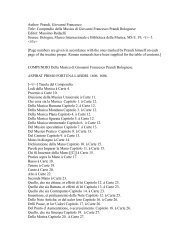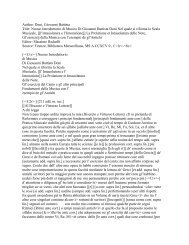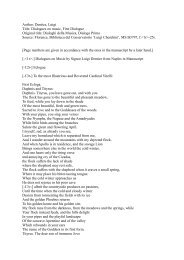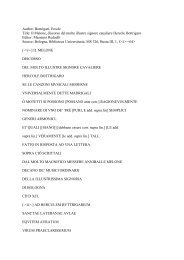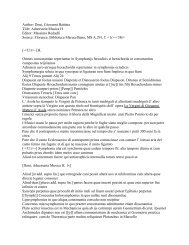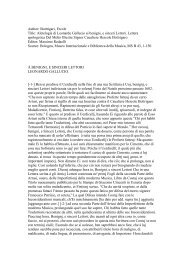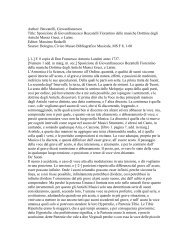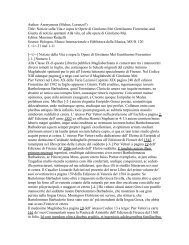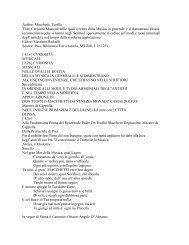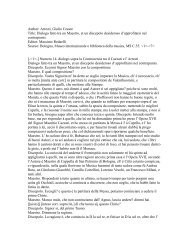Author: Doni, Giovanni Battista - manuscripts of italian music theory ...
Author: Doni, Giovanni Battista - manuscripts of italian music theory ...
Author: Doni, Giovanni Battista - manuscripts of italian music theory ...
Create successful ePaper yourself
Turn your PDF publications into a flip-book with our unique Google optimized e-Paper software.
[--] Which ones are the Mobile and which ones the Stable Notes <strong>of</strong> the System.<br />
The entire System is composed <strong>of</strong> stable and mobile notes. As stable notes we<br />
understand the ones which do not move otherwise in the various genera, as Cleonides’<br />
Introduction explains, which occurs by lowering them or raising them proportionately<br />
by tones as it is understood proportionately in the natural notes. Therefore, one has to<br />
know that place is defined in the System as the location, higher or lower, <strong>of</strong> the voice.<br />
For instance, if we suppose that from the lowest note that one can sing lowering the<br />
voice as much as one can up to the highest he shall be able to produce the span or<br />
interval <strong>of</strong> two octave, we can imagine for ourselves that there are an infinite number<br />
<strong>of</strong> places, either higher or lower, according as to whether the voice rises or descends,<br />
in this span contained within the two extremes <strong>of</strong> these octaves, just as in the example<br />
which I gave above <strong>of</strong> a string rubbed with a bow (which is alien to <strong>music</strong>) or divided<br />
into intervals (which one encountered in any melody sung or played) depending on<br />
whether someone pitches a sound higher or lower, we shall say that that note changes<br />
position stopping on a place which is either higher or lower. This same thing is<br />
understood to be happening in the notes <strong>of</strong> the entire System according to the variety<br />
<strong>of</strong> the genera, because, since the whole System is divided into four tetrachords and<br />
two extra to comprehend the notes contained within the extremes by the [--]<br />
Tetrachords and by the two Tones. The extreme notes <strong>of</strong> the Tetrachord and those<br />
which contain the above mentioned tones are called stable or immobile because they<br />
never rise or fall, while all the other ones, namely the two contained in each<br />
Tetrachord, are called Mobile, because, if in a genus they have produce a certain<br />
interval with each other and with the other two immobile ones, when the genus<br />
change they also change place and tension, by descending or ascending. This could be<br />
done in a man-made instrument <strong>of</strong> four notes by using pegs for the middle notes, as<br />
lute players do nowadays in the notes b fa [sqb] mi when they move from the disjunct<br />
System to the conjunct or the other way round. Therefore, in the disjunct system <strong>of</strong><br />
fifteen notes, in which the note b flat is not contained, the stable notes are the two<br />
Hypates, the two nete and the Paranetes with the Netes, which are the extremes <strong>of</strong> the<br />
tetrachord, and the Proslambanomenos which is outside <strong>of</strong> the tetrachords, while the<br />
Parhypates and the Lichani as well as the Trites are the mobile ones. And, because, if<br />
the conjunct tetrachord is also included, other notes are added there <strong>of</strong> which only<br />
one, namely the trite synemmenon, is different in sound, while the other differ only in<br />
name, equally in this tetrachord the Trite [--] and the paranete are mobile, while<br />
the Nete is stable. Therefore, as Bacchius says, the stable notes will be eight, namely<br />
the Proslambanomenos, Hypate Hypaton, Hypate meson, Nete, Paramese, Nete<br />
Synemmenon, Nete Diezeugmenon and Nete Hyperboleon, while, consequently, the<br />
other eight are mobile. And, since two notes <strong>of</strong> the Synemmenon Tetrachord are in<br />
unison with the other ones <strong>of</strong> the Diezeugmenon, namely the paranete synemmenon<br />
with the Trite Diezeugmenon and the Mese Synemmenon with the Paranete<br />
Diezeugmenon, this one, as Nete, shall be stable, and, as paranete, shall be monile.<br />
This can be easily gathered from the illustration. Therefore, see with what great<br />
facility, order and with what small number <strong>of</strong> notes and intervals the wise ancients<br />
constituted the System which embraces all that great variety which contains <strong>music</strong>.<br />
Therefore, since they wanted to facilitate this perfection instead <strong>of</strong> confusing it, as<br />
modern theorists have done with a farrago <strong>of</strong> useless words and signs (especially in<br />
the matter <strong>of</strong> time signatures) they were satisfied <strong>of</strong> the same notes and names <strong>of</strong> the<br />
other two genera by adding the word Diatonic, Chromatic or Enharmonic to the two



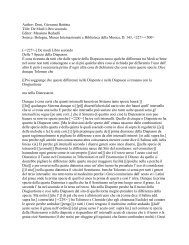
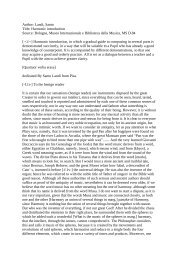
![Doni, Giovanni Battista Title: Trattato Dei Tuoni o [[Harmonie de]]](https://img.yumpu.com/45461005/1/190x245/doni-giovanni-battista-title-trattato-dei-tuoni-o-harmonie-de.jpg?quality=85)
